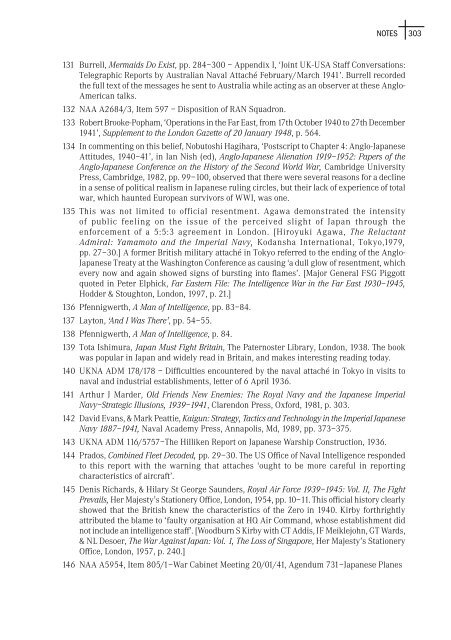Missing Pieces: - Royal Australian Navy
Missing Pieces: - Royal Australian Navy
Missing Pieces: - Royal Australian Navy
You also want an ePaper? Increase the reach of your titles
YUMPU automatically turns print PDFs into web optimized ePapers that Google loves.
nOTes<br />
131 Burrell, Mermaids Do Exist, pp. 284—300 — Appendix I, ‘Joint UK-USA Staff Conversations:<br />
Telegraphic Reports by <strong>Australian</strong> Naval Attaché February/March 1941’. Burrell recorded<br />
the full text of the messages he sent to Australia while acting as an observer at these Anglo-<br />
American talks.<br />
132 NAA A2684/3, Item 597 — Disposition of RAN Squadron.<br />
133 Robert Brooke-Popham, ‘Operations in the Far East, from 17th October 1940 to 27th December<br />
1941’, Supplement to the London Gazette of 20 January 1948, p. 564.<br />
134 In commenting on this belief, Nobutoshi Hagihara, ‘Postscript to Chapter 4: Anglo-Japanese<br />
Attitudes, 1940—41’, in Ian Nish (ed), Anglo-Japanese Alienation 1919—1952: Papers of the<br />
Anglo-Japanese Conference on the History of the Second World War, Cambridge University<br />
Press, Cambridge, 1982, pp. 99—100, observed that there were several reasons for a decline<br />
in a sense of political realism in Japanese ruling circles, but their lack of experience of total<br />
war, which haunted European survivors of WWI, was one.<br />
135 This was not limited to official resentment. Agawa demonstrated the intensity<br />
of public feeling on the issue of the perceived slight of Japan through the<br />
enforcement of a 5:5:3 agreement in London. [Hiroyuki Agawa, The Reluctant<br />
Admiral: Yamamoto and the Imperial <strong>Navy</strong>, Kodansha International, Tokyo,1979,<br />
pp. 27—30.] A former British military attaché in Tokyo referred to the ending of the Anglo-<br />
Japanese Treaty at the Washington Conference as causing ‘a dull glow of resentment, which<br />
every now and again showed signs of bursting into flames’. [Major General FSG Piggott<br />
quoted in Peter Elphick, Far Eastern File: The Intelligence War in the Far East 1930—1945,<br />
Hodder & Stoughton, London, 1997, p. 21.]<br />
136 Pfennigwerth, A Man of Intelligence, pp. 83—84.<br />
137 Layton, ‘And I Was There’, pp. 54—55.<br />
138 Pfennigwerth, A Man of Intelligence, p. 84.<br />
139 Tota Ishimura, Japan Must Fight Britain, The Paternoster Library, London, 1938. The book<br />
was popular in Japan and widely read in Britain, and makes interesting reading today.<br />
140 UKNA ADM 178/178 — Difficulties encountered by the naval attaché in Tokyo in visits to<br />
naval and industrial establishments, letter of 6 April 1936.<br />
141 Arthur J Marder, Old Friends New Enemies: The <strong>Royal</strong> <strong>Navy</strong> and the Japanese Imperial<br />
<strong>Navy</strong>—Strategic Illusions, 1939—1941, Clarendon Press, Oxford, 1981, p. 303.<br />
142 David Evans, & Mark Peattie, Kaigun: Strategy, Tactics and Technology in the Imperial Japanese<br />
<strong>Navy</strong> 1887—1941, Naval Academy Press, Annapolis, Md, 1989, pp. 373—375.<br />
143 UKNA ADM 116/5757—The Hilliken Report on Japanese Warship Construction, 1936.<br />
144 Prados, Combined Fleet Decoded, pp. 29—30. The US Office of Naval Intelligence responded<br />
to this report with the warning that attaches ‘ought to be more careful in reporting<br />
characteristics of aircraft’.<br />
145 Denis Richards, & Hilary St George Saunders, <strong>Royal</strong> Air Force 1939—1945: Vol. II, The Fight<br />
Prevails, Her Majesty’s Stationery Office, London, 1954, pp. 10—11. This official history clearly<br />
showed that the British knew the characteristics of the Zero in 1940. Kirby forthrightly<br />
attributed the blame to ‘faulty organisation at HQ Air Command, whose establishment did<br />
not include an intelligence staff’. [Woodburn S Kirby with CT Addis, JF Meiklejohn, GT Wards,<br />
& NL Desoer, The War Against Japan: Vol. 1, The Loss of Singapore, Her Majesty’s Stationery<br />
Office, London, 1957, p. 240.]<br />
146 NAA A5954, Item 805/1—War Cabinet Meeting 20/01/41, Agendum 731—Japanese Planes<br />
303

















